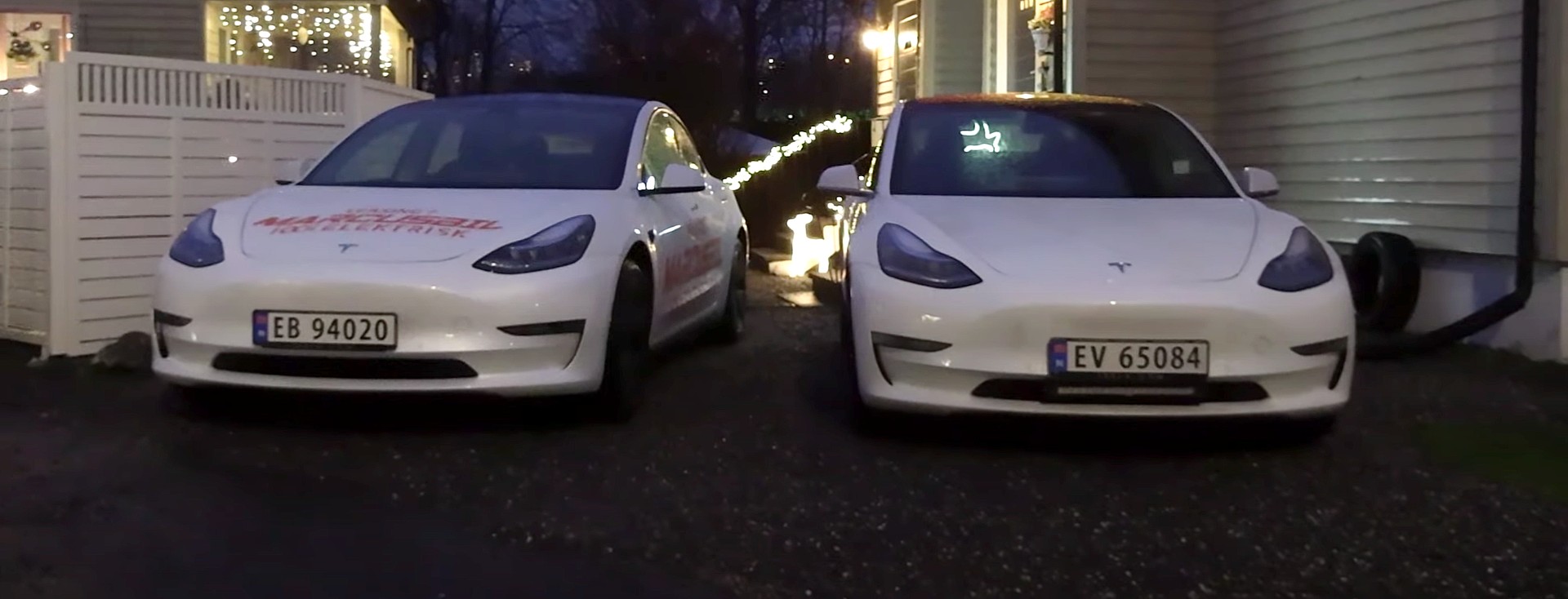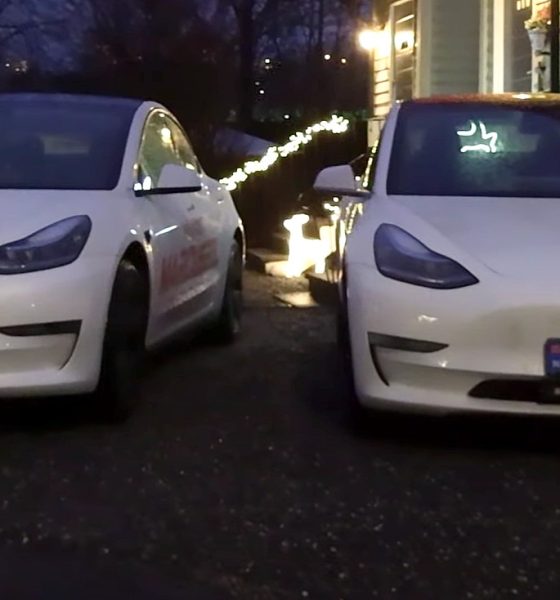

News
Tesla’s Model 3 Heat Pump is a game changer compared to its old system
Tesla’s addition of a Heat Pump to its 2021 Model 3 was installed with the intention of bringing owners of the company’s most affordable vehicle more range and more efficiency. Now that the newly “refreshed” Model 3 is making its way to owners, it is proving to be around three times more efficient than older builds of the vehicle.
A new video from well-known EV content creator and Tesla owner Bjørn Nyland showed that the heat pump gives owners around three times the efficiency compared to the previous HVAC system, which used a Positive Temperature Coefficient, or PTC system. This proves the addition of the heat pump was a strategy that will end up paying dividends to owners in cold climates, especially now as the Winter months are making their way to many owners across the U.S. and European markets.
Nyland compared a brand new 2021 Model 3 to his older version of the car, which does not have a heat pump equipped. Performing stationary tests to see which system was more efficient in heating up the vehicle during a chilly December night was the perfect test in Nyland’s eyes, and he came out of it with results that proved Tesla’s new system was superior to the old one.
Nyland used Camp Mode to test the efficiency of the two cars. Camp Mode maintains a temperature in the cabin while the vehicle is stationary and is ideal for those who sleep in their cars overnight. Because it uses energy from the car’s battery to maintain a comfortable cabin temperature, it was ideal for it to be used during this testing scenario.
After three hours of heating the cabin, both vehicles showed a drop in the state of charge, of course. However, the differences in the drop were night and day. The heat pump-equipped 2021 Model 3 had dropped only 3% in the three-hour span, while the sedan’s pre-heat pump variant had lost 10% of its battery.
The 2021 Model 3 has a 73.5 kWh battery pack with little-t0-no degradation due to its new powertrain that had only 65 kilometers on it. It used only 735 W of energy per hour, meaning 2,205 W were used over the course of the test.
The older Model 3 evidently did not have the efficiency that the new, heat pump-outfitted Model 3 did. After starting at 56%, the three hours of heating the cabin had brought the car’s state of charge down to 46%, meaning it was using roughly three times the amount of energy that the heat pump did. This equated to 2170 W of energy being used per hour by the old Model 3.
It is no secret that using a heat pump is more efficient than the past PTC HVAC system was. Tesla installed the heat pump in the Model Y and made it standard upon the car’s first deliveries in March 2020. Tesla decided to then make it standard in the Model 3 after refreshing the car in October 2020.
Tesla formally adds Heat Pump to Model 3 parts catalog after ‘refresh’
More tests are likely to come that will compare the two systems, but this test shows the efficiency differences in the two cars while heating up. If you’re spending nights in your Model 3, the new 2021 variant may be the way to go to alleviate any concerns about range diminishment overnight.
Nyland’s video comparing the two Tesla vehicles is available below.

News
Tesla FSD fleet is nearing 7 billion total miles, including 2.5 billion city miles
As can be seen on Tesla’s official FSD webpage, vehicles equipped with the system have now navigated over 6.99 billion miles.

Tesla’s Full Self-Driving (Supervised) fleet is closing in on almost 7 billion total miles driven, as per data posted by the company on its official FSD webpage.
These figures hint at the massive scale of data fueling Tesla’s rapid FSD improvements, which have been quite notable as of late.
FSD mileage milestones
As can be seen on Tesla’s official FSD webpage, vehicles equipped with the system have now navigated over 6.99 billion miles. Tesla owner and avid FSD tester Whole Mars Catalog also shared a screenshot indicating that from the nearly 7 billion miles traveled by the FSD fleet, more than 2.5 billion miles were driven inside cities.
City miles are particularly valuable for complex urban scenarios like unprotected turns, pedestrian interactions, and traffic lights. This is also the difference-maker for FSD, as only complex solutions, such as Waymo’s self-driving taxis, operate similarly on inner-city streets. And even then, incidents such as the San Francisco blackouts have proven challenging for sensor-rich vehicles like Waymos.
Tesla’s data edge
Tesla has a number of advantages in the autonomous vehicle sector, one of which is the size of its fleet and the number of vehicles training FSD on real-world roads. Tesla’s nearly 7 billion FSD miles then allow the company to roll out updates that make its vehicles behave like they are being driven by experienced drivers, even if they are operating on their own.
So notable are Tesla’s improvements to FSD that NVIDIA Director of Robotics Jim Fan, after experiencing FSD v14, noted that the system is the first AI that passes what he described as a “Physical Turing Test.”
“Despite knowing exactly how robot learning works, I still find it magical watching the steering wheel turn by itself. First it feels surreal, next it becomes routine. Then, like the smartphone, taking it away actively hurts. This is how humanity gets rewired and glued to god-like technologies,” Fan wrote in a post on X.
News
Tesla starts showing how FSD will change lives in Europe
Local officials tested the system on narrow country roads and were impressed by FSD’s smooth, human-like driving, with some calling the service a game-changer for everyday life in areas that are far from urban centers.

Tesla has launched Europe’s first public shuttle service using Full Self-Driving (Supervised) in the rural Eifelkreis Bitburg-Prüm region of Germany, demonstrating how the technology can restore independence and mobility for people who struggle with limited transport options.
Local officials tested the system on narrow country roads and were impressed by FSD’s smooth, human-like driving, with some calling the service a game-changer for everyday life in areas that are far from urban centers.
Officials see real impact on rural residents
Arzfeld Mayor Johannes Kuhl and District Administrator Andreas Kruppert personally tested the Tesla shuttle service. This allowed them to see just how well FSD navigated winding lanes and rural roads confidently. Kruppert said, “Autonomous driving sounds like science fiction to many, but we simply see here that it works totally well in rural regions too.” Kuhl, for his part, also noted that FSD “feels like a very experienced driver.”
The pilot complements the area’s “Citizen Bus” program, which provides on-demand rides for elderly residents who can no longer drive themselves. Tesla Europe shared a video of a demonstration of the service, highlighting how FSD gives people their freedom back, even in places where public transport is not as prevalent.
What the Ministry for Economic Affairs and Transport says
Rhineland-Palatinate’s Minister Daniela Schmitt supported the project, praising the collaboration that made this “first of its kind in Europe” possible. As per the ministry, the rural rollout for the service shows FSD’s potential beyond major cities, and it delivers tangible benefits like grocery runs, doctor visits, and social connections for isolated residents.
“Reliable and flexible mobility is especially vital in rural areas. With the launch of a shuttle service using self-driving vehicles (FSD supervised) by Tesla in the Eifelkreis Bitburg-Prüm, an innovative pilot project is now getting underway that complements local community bus services. It is the first project of its kind in Europe.
“The result is a real gain for rural mobility: greater accessibility, more flexibility and tangible benefits for everyday life. A strong signal for innovation, cooperation and future-oriented mobility beyond urban centers,” the ministry wrote in a LinkedIn post.
News
Tesla China quietly posts Robotaxi-related job listing
Tesla China is currently seeking a Low Voltage Electrical Engineer to work on circuit board design for the company’s autonomous vehicles.

Tesla has posted a new job listing in Shanghai explicitly tied to its Robotaxi program, fueling speculation that the company is preparing to launch its dedicated autonomous ride-hailing service in China.
As noted in the listing, Tesla China is currently seeking a Low Voltage Electrical Engineer to work on circuit board design for the company’s autonomous vehicles.
Robotaxi-specific role
The listing, which was shared on social media platform X by industry watcher @tslaming, suggested that Tesla China is looking to fill the role urgently. The job listing itself specifically mentions that the person hired for the role will be working on the Low Voltage Hardware team, which would design the circuit boards that would serve as the nervous system of the Robotaxi.
Key tasks for the role, as indicated in the job listing, include collaboration with PCB layout, firmware, mechanical, program management, and validation teams, among other responsibilities. The role is based in Shanghai.
China Robotaxi launch
China represents a massive potential market for robotaxis, with its dense urban centers and supportive policies in select cities. Tesla has limited permission to roll out FSD in the country, though despite this, its vehicles have been hailed as among the best in the market when it comes to autonomous features. So far, at least, it appears that China supports Tesla’s FSD and Robotaxi rollout.
This was hinted at in November, when Tesla brought the Cybercab to the 8th China International Import Expo (CIIE) in Shanghai, marking the first time that the autonomous two-seater was brought to the Asia-Pacific region. The vehicle, despite not having a release date in China, received a significant amount of interest among the event’s attendees.








